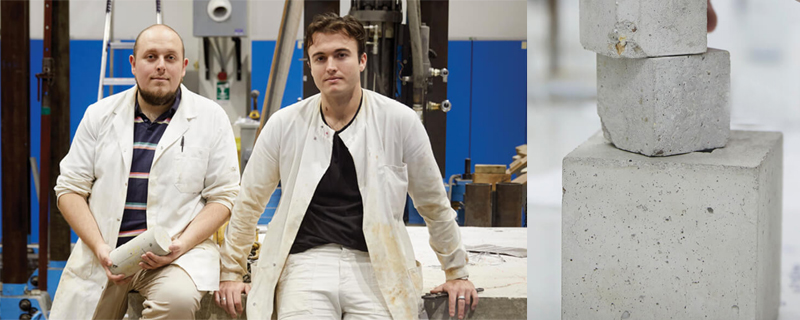Material scientists Barney Shanks and Sam Draper are lauded for their efforts in helping eliminate carbon emissions from the building and construction industry.
On October 06, 2022, Copenhagen-based Henrik Frode Obel Foundation announced material technology company Seratech as the winner of Obel Award 2022. The architecture award recognised the efforts of the company’s material scientists and London’s Imperial College PhD students Barney Shanks and Sam Draper in creating a solution against the alarming carbon footprint generated by the building and construction industry. The duo have created a carbon-neutral concrete through an efficient, low-cost process using materials that are naturally available all over the globe. The technology, according to Obel Award jury, best represents the 2022 theme of the award – ‘Embodied Emissions’ – referring to the irreversible and unremedied amount of CO2 that’s released in the construction of concrete architecture, and the need to sequester the problem at source.
Seratech’s solution is about capturing carbon from various industrial production processes to create a 100 per cent carbon neutral product that serves to potentially reduce embodied emissions. Though still at the ‘lab level’, the company hopes to scale up the concrete’s production in the near future to help achieve low carbon constructions.
Through this year’s thematic and the corresponding winner, the OBEL Award jury highlights the need for innovative and flexible cross-disciplinary solutions to combat climate change. Lauding Seratech’s endeavour, the jury shared that “it is necessary to encourage ambitious, cross disciplinary ideas that do not just provide a temporary or a small scale fix nor an unrealistic shift in the current practices.” The jury consisted of Martha Schwartz, as Chair (Founder, Martha Schwartz Partners, USA), Kjetil Trædal Thorsen (Co-founder, Snöhetta, Norway), Louis Becker (Design Principal and Partner, Henning Larsen, Denmark), Dr Wilhelm Vossenkuhl (Professor Emeritus of Philosophy, Germany), and XU Tiantian (Founding Principal, DnA, Beijing, China).
The fourth honouree to have received the annual prize that “recognises exceptional architectural contributions to human development”, Seratech’s winning new age concrete is preceded by Professor Carlos Menos’ urban design proposal 15-miuute city (2021), German architect Anna Herringer’s multi-layered building Anandaloy (2020) from northern Bangladesh, and Japanese architect Junya Ishigami’s Water Garden as the 2019 winner.
So how is this concrete actually produced? Co-founders Shanks and Draper have mechanised a chemical process of capturing and storing C02 to create an alternative to Portland cement in the concrete composition.
“We found a way to take the world’s most abundant waste product, CO2, and react it with the world’s most abundant mineral, magnesium silicate. In doing this, we produce two things: magnesium carbonate and silica,” says Shanks. “But the really exciting bit is the silica. We use this as a cement replacement material, and if this is scaled globally, not only does it cut Portland cement production by 30 per cent, but also sequesters the emissions from the remaining 70 per cent, resulting in carbon-neutral concrete,” Draper, the company’s CEO adds.
A private limited company comprising a team of scientists, engineers and business leaders, Seratech’s technology has been in development since late 2020 and is currently working on the design of a pilot plant to model the process at a large scale. Following acceptance into the climate-tech accelerator Greenhouse in August 2021, the company has also received two grants totalling £212k to hire more researchers in its team, in addition to being featured as a case study in The Green Construction Board’s ‘Low Carbon Concrete Routemap’.
“The overall idea with this project,” according to Seratech’s Chief Technical Officer Barney Shanks, “is essentially where finding a way to reduce the carbon emissions associated with cement and concrete is zero but without impacting the properties of cement and concrete itself. If it is fully adopted, this technology eliminates three billion tonnes of CO2 being released in the atmosphere every year.”
In this time of aggressive urbanisation where the need for concrete and cement is seeing a continual rise, and which is only expected to increase in the future, Seratech’s sustainable endeavour brings a ray of hope in significantly decarbonising the construction industry. Draper and Shanks will receive a prize sum of EUR 100,000 and an artwork by Barcelona-based artist Tomás Saraceno at the Obel Award official ceremony, to be hosted at the Utzon Centre in Aalborg, Denmark, on October 25, 2022.





Leave a Reply
Want to join the discussion?Feel free to contribute!